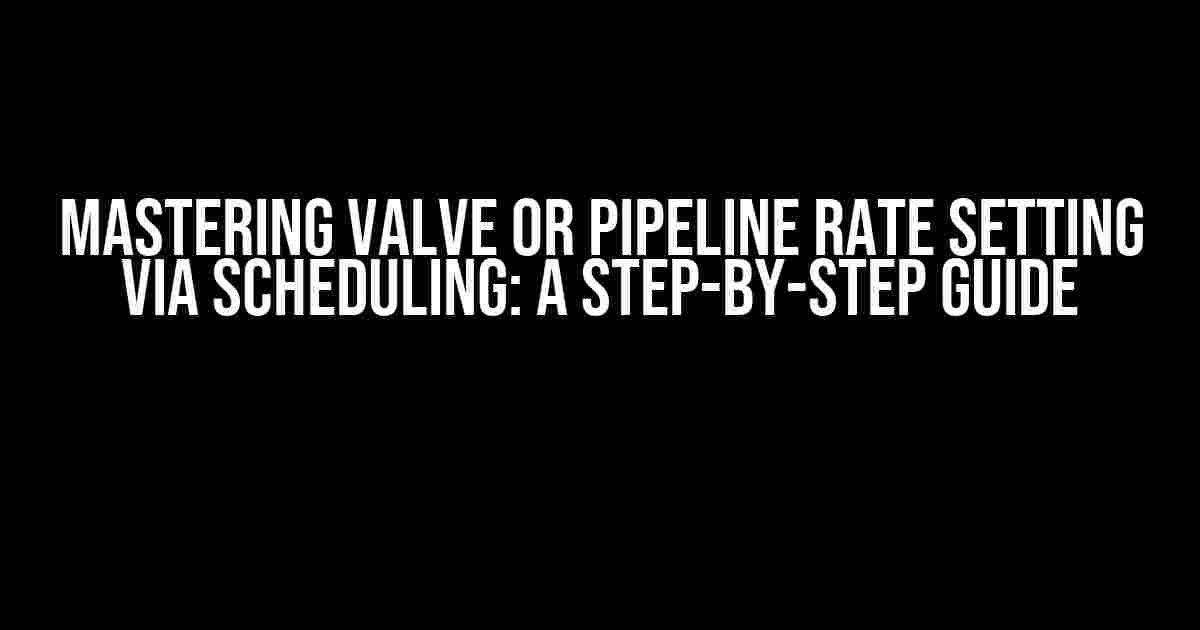Are you tired of struggling with valve or pipeline rate settings, only to find yourself stuck in a never-ending cycle of trial and error? Look no further! In this comprehensive guide, we’ll delve into the world of valve or pipeline rate setting via scheduling, providing you with clear, actionable instructions to optimize your processes and take your operations to the next level.
Understanding the Basics: Valve or Pipeline Rate Setting
Before we dive into the nitty-gritty of scheduling, let’s cover the fundamentals of valve or pipeline rate setting. In essence, this process involves controlling the flow rate of fluids, gases, or other substances through a pipeline or valve system. The goal is to achieve a precise flow rate, ensuring efficient and safe operations.
Why Scheduling Matters
- Accurate flow rate control minimizes waste and reduces costs
- Optimized flow rates enhance product quality and integrity
- Scheduling enables real-time monitoring and adjustment
- Automated control reduces operator error and improves safety
Setting Up Your Scheduling System
To get started, you’ll need a few essential components:
- A programmable logic controller (PLC) or distributed control system (DCS)
- A valve or pipeline system with actuation and sensing capabilities
- A human-machine interface (HMI) for operator input and monitoring
- A scheduling software or algorithm
Configuring Your PLC/DCS
// Sample PLC code for valve control
ivalent Valve1.open = 0; // Initialize valve as closed
ivalent Valve1.close = 100; // Initialize valve as fully closed
// Define flow rate setpoints
ivalent FlowRate_Low = 100; // Low flow rate (e.g., 100 mL/min)
ivalent FlowRate_High = 500; // High flow rate (e.g., 500 mL/min)
// Schedule valve opening based on flow rate setpoints
if (FlowRate >= FlowRate_Low && FlowRate <= FlowRate_High) {
Valve1.open = (FlowRate - FlowRate_Low) / (FlowRate_High - FlowRate_Low) * 100;
}
In this example, we’ve configured the PLC to control a valve based on flow rate setpoints. The valve opening is calculated as a percentage of the flow rate range, ensuring precise control.
Scheduling Algorithms and Strategies
Now that you’ve set up your system, it’s time to explore scheduling algorithms and strategies. These will help you optimize your valve or pipeline rate setting based on various factors, such as:
Scheduling Based on Time of Day
Use a time-based scheduling algorithm to adjust flow rates during peak or off-peak hours.
| Time | Flow Rate (mL/min) |
|---|---|
| 06:00 – 08:00 | 200 |
| 08:00 – 16:00 | 500 |
| 16:00 – 22:00 | 300 |
| 22:00 – 06:00 | 100 |
Scheduling Based on Pressure or Temperature
Use a pressure- or temperature-based scheduling algorithm to adjust flow rates in response to changing process conditions.
// Sample temperature-based scheduling algorithm
if (Temperature > 80°C) {
FlowRate = FlowRate_High;
} else if (Temperature < 60°C) {
FlowRate = FlowRate_Low;
} else {
FlowRate = (FlowRate_High - FlowRate_Low) * (Temperature - 60°C) / 20°C + FlowRate_Low;
}
Scheduling Based on Flow Rate Feedback
Use a feedback-based scheduling algorithm to adjust flow rates in real-time based on sensor data.
// Sample feedback-based scheduling algorithm
FlowRate_Error = FlowRate_Setpoint - FlowRate_Actual;
if (FlowRate_Error > 10%) {
Valve.open += 10;
} else if (FlowRate_Error < -10%) {
Valve.open -= 10;
}
Implementing and Testing Your Scheduling System
Now that you’ve configured your system and selected a scheduling algorithm, it’s time to put it all into practice.
- Upload your scheduling algorithm to the PLC/DCS
- Configure the HMI for operator input and monitoring
- Connect sensors and actuators to the PLC/DCS
- Test the system under various operating conditions
- Monitor and adjust the system as needed
Troubleshooting Common Issues
- Inaccurate flow rate measurements: Check sensor calibration and installation
- Valve or pipeline obstruction: Check for blockages or debris
- Inconsistent scheduling: Verify algorithm logic and PLC/DCS configuration
- Operator input errors: Implement input validation and error handling
Conclusion
Mastering valve or pipeline rate setting via scheduling requires a deep understanding of the underlying principles, algorithms, and system configurations. By following this comprehensive guide, you’ll be well on your way to optimizing your processes, reducing waste, and improving overall efficiency. Remember to stay flexible and adapt to changing process conditions, and don’t hesitate to seek help when needed.
Happy scheduling!
Frequently Asked Question
Get your pipeline rate setting via scheduling queries answered!
What is valve or pipeline rate setting via scheduling?
Valve or pipeline rate setting via scheduling is a process that allows you to control the flow rate of a pipeline by scheduling the valve opening and closing times. This process ensures that the pipeline operates within a specific flow rate, reducing the risk of over-pressurization, under-pressurization, or other safety issues.
How does valve or pipeline rate setting via scheduling work?
The process involves integrating a control system with a scheduling mechanism that sends signals to the valves to open or close at specific times. The scheduling system takes into account various factors, such as pipeline capacity, flow rate requirements, and pressure constraints, to optimize the valve operation and maintain a stable flow rate.
What are the benefits of valve or pipeline rate setting via scheduling?
The benefits of valve or pipeline rate setting via scheduling include improved pipeline safety, increased efficiency, and reduced operating costs. By maintaining a stable flow rate, you can minimize the risk of pipeline ruptures, reduce energy consumption, and optimize production.
Can valve or pipeline rate setting via scheduling be used for both liquid and gas pipelines?
Yes, valve or pipeline rate setting via scheduling can be applied to both liquid and gas pipelines. The process is flexible and can be tailored to meet the specific requirements of different pipeline types and applications.
Is valve or pipeline rate setting via scheduling a complex process to implement?
While valve or pipeline rate setting via scheduling does require some planning and configuration, it is not necessarily a complex process to implement. With the right expertise and technology, the process can be streamlined and integrated with existing pipeline control systems.
